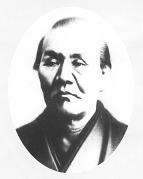From 1874 - 90 Jiro-cho was in charge of a company that developed the land around Fuji and Susono cities. Using prisoners as laborers, acres of rocky soil were made suitable for agriculture. Several Shinto shrines built by Jiro-cho stand there today.
In 1884 the Imperial Police initiated a crackdown on gambling. Jiro-cho was arrested and sentenced to seven years behind bars. Thanks to his powerful connections, however, he was released after 23 months. After prison, Jiro-cho opened
a Japanese style inn near Hi-no-de Wharf in Shimizu. This remained in business until the Taisho era.
Although Jiro-cho married four times, he had no direct offspring. For a period he adopted Yamamoto Goro, whose father was killed in the Bosshin rebellion. Goro lived with Jiro-cho for ten years and wrote a vivid story about his life which helped transform Jiro-cho from a petty gang lord into a legend. However, Goro wasn't really cut out for Jiro-cho's lifestyle; he decided to become an imperial retainer and later a Buddhist monk.
During his remaining years, Jiro-cho became affectionately known as "the Old Man of the Harbor". He promoted many businesses in Shimizu and other in parts of the prefecture. Jiro-cho's projects included an oil field drilling program near Omaezaki, a special sumo event in Shizuoka, and contracts to expand Shimizu Harbor, where steamships and Imperial Navy vessels frequently called.
On June 12, 1893 Jiro-cho passed away. Eight thousand people attended his funeral and he was awarded the posthumous name "Seikiryou Kenyuuzan Gikaikouji". Today magnificent memorials to him are found at Baienji and Tesshuuji temples. In a sense, Shimizu Harbor is also part of his memorial.
Those interested in learning more about Jiro-cho should visit his birthhouse at 4-16 Minowa-cho. Located about 300 meters west of the Minato-bashi bridge, it is open from 9:00 to 5:00 everyday but Wednesday. Baienji and Tesshuuji temples are also worth visiting.
- Tim Newfields

www.tnewfields.info/sb/jiro.htm
copyright 1997 by Tim Newfields and the Shizuokoa City International Association




![]()